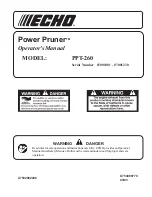
10
GB
5. Squeeze the trigger.
6. Select the speed with
control (9).
7. Place the shoe on the
workpiece and begin sawing.
Note.
Use only enough pressure
to keep the saw cutting. Do not
force the cutting; allow the blade
and the saw to do the work.
WARNING.
Use of excessive
pressure that causes bending or
twisting of the blade may cause
the blade to break.
Plunge cutting
1. Mark the line of the cut.
2. Choose a point inside the area
to be cut out and place the tip
of the blade over that point.
3. Rest the front edge of the shoe
on the workpiece and hold the
saw firmly in position.
4. Press the lock-off button and
squeeze the trigger to start
the cutting action.
WARNING.
Make sure that
the blade does not touch the
workpiece until the blade has
reached maximum speed since
this could cause loss of control
and serious injury. Cut slowly until
the blade has fully penetrated the
thickness of the workpiece
Metal cutting
Metals such as sheet steel, pipe,
steel rods, aluminium, brass and
copper can be cut with your saw.
Be careful not to bend or twist the
blade and do not force the
cutting action.
We recommend that you use
cutting oil to lubricate the cut
when sawing soft metals and
steel.
It keeps the blade cooler and prolongs blade life.
CAUTION.
Clamp the work firmly and cut close to the
clamping point to minimise vibration. When cutting conduit
pipe or angle iron, clamp the work in a vice if possible and
cut close to the vice. To cut thin sheet metal, sandwich the
sheet between hardboard or plywood and clamp the layers
to prevent vibration and the tearing of the metal.
RC1200 Manual ed2.indd 10
12/8/09 16:13:12
Summary of Contents for RC1200
Page 23: ...NL 23 RC1200 Manual ed2 indd 23 12 8 09 16 13 18 ...
Page 35: ...F 35 RC1200 Manual ed2 indd 35 12 8 09 16 13 23 ...
Page 47: ...D 47 RC1200 Manual ed2 indd 47 12 8 09 16 13 29 ...
Page 59: ...I 59 RC1200 Manual ed2 indd 59 12 8 09 16 13 34 ...
Page 71: ...E 71 RC1200 Manual ed2 indd 71 12 8 09 16 13 39 ...
Page 72: ...72 E RC1200 Manual ed2 indd 72 12 8 09 16 13 39 ...











































